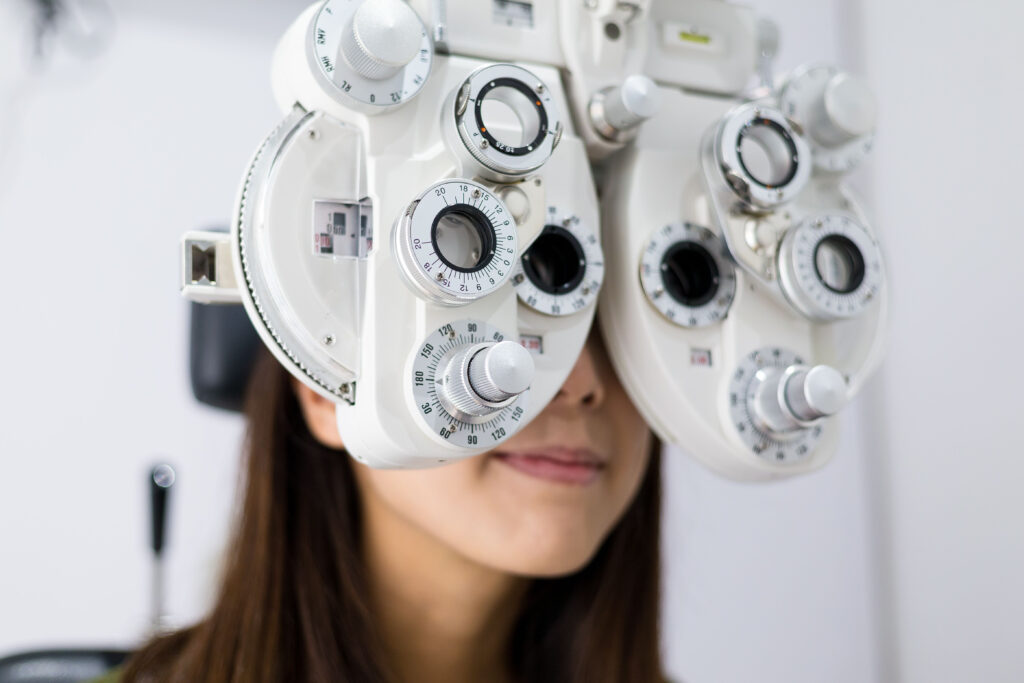In a world where we often gauge our health by how we feel, our eyes can sometimes be the forgotten sentinels of our well-being. The truth is that changes in our vision are often gradual, and we might not realize something is amiss until it becomes obvious. 10 signs that you should see an eye doctor include:
- Blurred vision
- Eye pain or discomfort
- Headaches
- Trouble seeing at night
- Light sensitivity
- Persistent dry eyes
- Double vision
- Changing eye color
- Halos around light
- Family history of eye conditions
You should see your eye doctor for a comprehensive examination every 1 to 2 years in most cases. This schedule is what the American Optometric Association and most eye doctors recommend.
It’s important to remember that you shouldn’t wait if problems come up between your regular visits. Your optometrist knows your situation, so they may recommend more frequent examinations based on your previous eye conditions, family history, or overall eye health.
Should You Book an Eye Exam?
There isn’t a one-size-fits-all answer. The ten signs we’re about to discuss don’t necessarily mean you need to panic. For example, headaches could be unrelated to an eye issue. But you know your body the best. If something feels off and you’re experiencing one or more of these issues, you should see your eye doctor for an examination.
Blurred Vision
Blurry vision can be frustrating and can manifest in many ways. You might struggle to read street signs, see clearly in low light, or find your computer screen more challenging to decipher. The causes can vary from needing a new eyeglasses prescription to more complex issues like cataracts.
The ambiguity of the eye problems that blur our vision highlights the necessity to see a professional to pinpoint and adequately address the problem. Ignoring blurry vision isn’t just about missing out on the finer details of life; it could be an opportunity to catch a more serious condition early.
Eye Pain or Discomfort
Our eyes are sensitive. They’re designed to pick up small disturbances, debris, and environmental changes. It’s time to look deeper if you start feeling pain or discomfort that known causes can’t explain, like allergies.
Chronic pain or severe discomfort can be related to overusing the eyes, like in a severe case of digital eye strain. It can also be indicative of issues requiring professional intervention, like glaucoma or corneal ulcers.
Headaches
It’s common knowledge that much of our daily grind can cause headaches—stress, dehydration, and the dreaded screen time among them. When eye pain accompanies your headaches, there’s more reason for concern, and an eye examination can help rule out an eye condition being the root cause.
Trouble Seeing at Night
Night blindness can be a symptom of deteriorating health in your eyes, commonly linked to retinitis pigmentosa or cataracts. Trouble seeing at night can be a sign to visit your eye doctor when accompanied by other symptoms like halos around lights or blurry vision.
Light Sensitivity
Photophobia—the technical term for light sensitivity—is more than just hating the glare of parking lot lights. It’s a genuine physical discomfort that can be linked to conditions where the eyes become inflamed, or the pupils cannot constrict properly.
Persistent Dry Eyes
When your eyes feel dry and gritty or produce too many tears to compensate, it’s time to consider seeing your eye doctor. Causes can be as mundane as living in a dry climate or spending too much time in air conditioning. It could also signal more serious conditions like Sjögren’s syndrome or blepharitis that can be chronic and require ongoing management.
Double Vision
Seeing double doesn’t need much explanation. It can happen with one eye closed or with both eyes open. Double vision could result from something relatively simple, like needing a new prescription, or something more complex, like diabetes or a neurological disorder.
Changing Eye Color
A shift in eye color could result from trauma, surgery, or medications. While sometimes it can be harmless, it could signal issues like pigmentary glaucoma or Fuchs heterochromic iridocyclitis.
Halos Around Lights
Seeing halos around lights can be linked to some of the conditions we’ve already mentioned, like cataracts or glaucoma. Glare, starbursts, and halos when driving at night can be more than an annoyance; they can be a severe hazard and indicate changes in your eyes that require attention to prevent further vision loss or discomfort.
Family History of Eye Conditions
Sometimes, our family history is the best predictor of what’s to come. If you have close relatives with eye diseases or vision problems, you should be more proactive in your eye care. Conditions like macular degeneration, glaucoma, and cataracts can have a genetic component, making them more likely to appear in the family tree.
Knowing your family history and sharing it with your eye care professional can help guide your vision care, which is all about forecasting and acting before the vision gets cloudy.

Take a Step Toward Clear Vision
Your eyesight is too precious to leave to chance or delay for convenience. Take the initiative and prioritize your ocular health. Contact our experienced team at Pack & Bianes Optometry Terra Nova if you’re experiencing anything we discussed today or if it’s time for your next eye exam.



